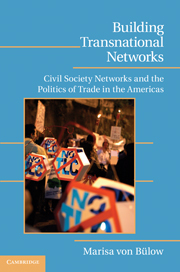Book contents
- Frontmatter
- Contents
- List of Figures
- List of Tables
- Acknowledgments
- Part One Civil Society Organizations and Their Pathways to Transnationality
- Part Two The Politicization of Trade
- Part Three The Dynamics of Networks
- Part Four Organizational Pathways to Transnationality
- 7 THE CREATION AND DEMISE OF TRANSNATIONAL COALITIONS
- 8 DIFFUSION AND DIFFERENTIATION OF NATIONAL COALITIONS
- Part Five The Search for Ideational Pathways
- Main Abbreviations Used
- Appendix A Lists of Interviews
- Appendix B Social Network Questionnaire (United States)
- Bibliography
- Index
8 - DIFFUSION AND DIFFERENTIATION OF NATIONAL COALITIONS
Published online by Cambridge University Press: 05 October 2010
- Frontmatter
- Contents
- List of Figures
- List of Tables
- Acknowledgments
- Part One Civil Society Organizations and Their Pathways to Transnationality
- Part Two The Politicization of Trade
- Part Three The Dynamics of Networks
- Part Four Organizational Pathways to Transnationality
- 7 THE CREATION AND DEMISE OF TRANSNATIONAL COALITIONS
- 8 DIFFUSION AND DIFFERENTIATION OF NATIONAL COALITIONS
- Part Five The Search for Ideational Pathways
- Main Abbreviations Used
- Appendix A Lists of Interviews
- Appendix B Social Network Questionnaire (United States)
- Bibliography
- Index
Summary
The creation of domestic trade coalitions in the Americas is an interesting example of transnational diffusion of new organizational formulas that sought to provide answers to problems of coordination, representation, mobilization, and knowledge production. In spite of the important differences among civil societies in the hemisphere, similar initiatives were diffused across national boundaries. The Mexican and the U.S. trade coalitions founded at the beginning of the 1990s were mirror images of the Action Canada Network that had been created earlier (see Figure 7.1). These, in turn, influenced the coalitions later created in the South of the hemisphere. For example, when debates about the need to create the national chapter of the Hemispheric Social Alliance (HSA) began in Brazil at the end of that decade, the way in which those involved in initial discussions framed their goal was “to create a Brazilian RMALC” (the Mexican Action Network on Free Trade). The experience of coalition building in the only developing country in the North American Free Trade Agreement (NAFTA) region was a key reference for the founders of the HSA chapter in Brazil, more so than the geographically closer experience of the Common Market of the South (MERCOSUR), which, as explained in the last chapter, had not generated sustained coordination across different civil society sectors in the 1990s.
- Type
- Chapter
- Information
- Building Transnational NetworksCivil Society and the Politics of Trade in the Americas, pp. 131 - 152Publisher: Cambridge University PressPrint publication year: 2010



